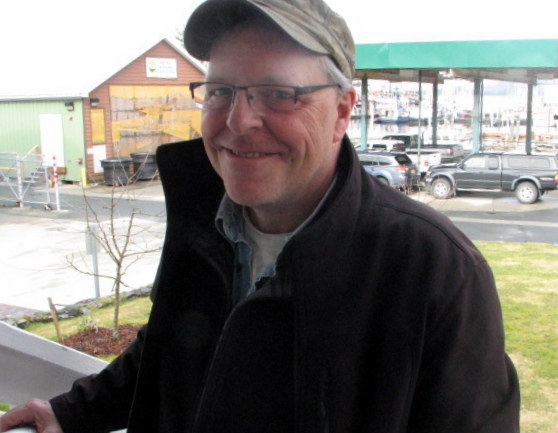
Former KCAW general manager Barnaby Dow has worked the last eleven years for King County in Seattle. (KCAW photo/Robert Woolsey)
President Obama’s visit to the landslide in Oso, Washington, this week (Tue Apr 22) was timed to refocus the nation’s attention on this disaster, long after the headlines have moved elsewhere.
The task in Oso is huge, and it will take a sustained federal, state, and local effort to restore anything close to normalcy in the devastated community.
A former Alaskan is closely involved in orchestrating relief work. Barnaby Dow is the external affairs manager in the King County Office of Emergency Management in Seattle. Dow was in Sitka briefly last week. He stopped by KCAW and spoke with Robert Woolsey about the ongoing effort in Oso.
Barnaby Dow has been with King County since 2003. Prior to that he was Parks and Rec coordinator for the City of Sitka for four years, and before that he was general manager of KCAW in Sitka, and KHNS in Haines.
Barnaby Dow doesn’t work out of Oso, which is in neighboring Snohomish County — in fact he hasn’t spent a single shift at the site of the slide — but it’s consumed him from the moment it happened just over a month ago.
He say it took a while for the scale of the Oso disaster sink in for people. And now it’s taking a while for the scale of the job ahead to sink in.
“We’re moving from the response phase into the recovery phase. Reuniting people with their belongings. Trying to identify the missing. Trying to recover the deceased.”
Dow says it’s not just about digging. Care is needed, because Oso is also a burial site.
“It’s a painstaking effort that’s going to take a lot. They’ve carved it up by parcel, based on the planning and zoning maps they have, and they’re going through it systematically from where the slide ended up into these zones where these lots are. So, it’s going to take a while.”
The aerial pictures, the thumbnails on the internet, don’t really do justice to the slide. Dow says university seismologists have released a report on Oso that strains belief. The slide rolled in like a freight train, at highway speeds.
Dow – The total amount of that slide was equal to the metric tonnage of the concrete in the Hoover Dam, times two. It’s an enormous amount of soil and vegetation that was moved as a result of the slide.
KCAW – And this happened in a matter of minutes?
Dow – In a matter of seconds, really. The scientists that are involved in looking back at this event say that this massive slide, as it moved in across the river and through the populated area, was probably traveling at somewhere around 60 miles per hour — and I find that amazing, considering this thing was anywhere between 30 and 70 feet deep when it did that.
Once emergency managers absorbed the scale of the disaster, Dow says it was a quick ramp up into action. His first job was to help set up a joint information center in Arlington, which is next-door to Oso. Up to a dozen public information officers a day were detailed to the center to manage the crush of worldwide media that descended on the site.
But Dow’s responsibilities don’t just involve the press.
This is a situation that emergency managers train over and over again for. There’s a certain foxhole mentality in emergency management, and when the event comes along you hope all the players can cooperate well with each other. In my job in King County Emergency Management, I coordinate the assets and the people that are available within King County and our 39 cities, and all the different firehalls and fire mobilization units, and search and rescue units, sheriff’s offices. It’s kind of like being in air traffic control. Your job is to get a list together based on experience and expertise, line up suggested teams, send them through the emergency operations center, where they will select and send out people to the field.
Dow was in Sitka a little over a week before President Obama’s scheduled visit to Oso, on a stopover at the beginning of his Asian tour. A presidential visit brings unimaginable headaches for emergency managers, but Dow says it’s an important time, as media attention wanes on Oso, and the heavy lifting of recovery could last a year.
A month after is symbolic, and I think helpful and appropriate for a national leader to appear. I can’t imagine what it’s like trying to decide when to go or not to go to a major event. But the public has an expectation that after a major disaster the Commander-in-Chief — some people say the Comforter-in-Chief — to report and offer solace to the community.
Dow’s visit to Sitka was welcome relief. He says the emergency management system builds in time and resources for people to decompress. There may not be another Oso, but the next disaster could roll at any time.
We’ve had 13 presidentially-declared disasters in King County alone, but they’re usually floods or a severe storm of some type. And frankly, we’re geared up for that: We know what to do, we have volunteers on the ground, we have people who know the drill when something happens. The utility companies know where to go and what to do. This slide is unprecedented. It’s probably going to go down in the books as one of the worst disasters in Washington state history.































